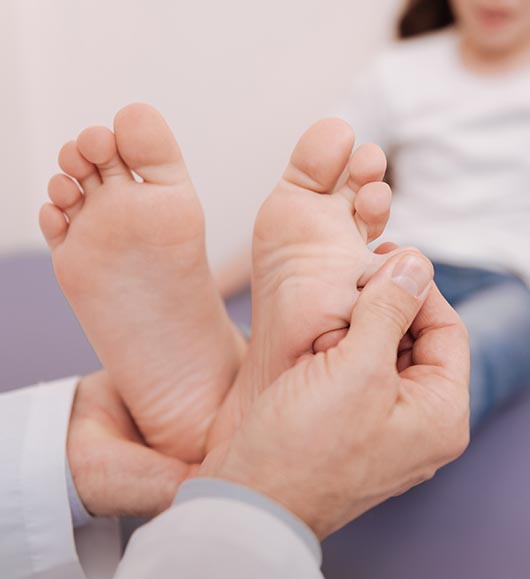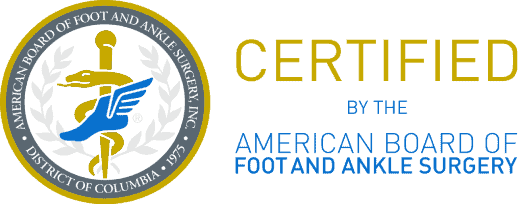Pediatric Ingrown Toenails
Symptoms, Causes and Treatment of Ingrown Toenails in Children
Ingrown toenails, medically known as Onychocryptosis, occur when the edge of a toenail grows into the surrounding skin, causing pain, swelling, and sometimes infection.
This condition is especially common in children, affecting any toe but most often the big toe.
Factors contributing to ingrown toenails include pressure from tight-fitting shoes, improper toenail trimming, stubbing the toe, and certain foot or toe deformities.

In this video Dr. Mikkel Jarman discusses ingrown toenails and some of their causes and concerns in children. Ingrown toenails are one of the most common nail problems seen at our office.
Common Causes
Ingrown toenails can form due to various reasons, such as:
- Tight-Fitting Shoes: Shoes that squeeze the toes together can cause nails to grow into the skin.
- Improper Toenail Trimming: Cutting toenails too short or rounding the edges can encourage the nail to grow into the skin.
- Toe Injuries: Stubbing the toe or repetitive stress from activities like sports can lead to ingrown nails.
- Genetics: Some children inherit a natural tendency for curved toenails, making them more prone to ingrown nails.
Recognizing the Symptoms
Parents should be vigilant in spotting the symptoms of ingrown toenails in their children. Common signs include:
- Pain and Tenderness: The affected toe may be painful, especially when touched or squeezed by shoes or socks.
- Redness and Swelling: The skin around the ingrown nail may appear red, swollen, and warm to the touch.
- Infection Signs: If the condition worsens, the area might become infected, showing pus or increased redness and swelling.
- Behavioral Changes: Babies may cry and pull at their toes, while toddlers might limp or grimace when walking.

Treatment for babies & Toddlers
Dr. Jarman emphasizes a straightforward and effective approach specifically tailored for young children. Rather than relying solely on antibiotics—which can often be ineffective against resistant infections—he recommends a gentle nail avulsion procedure, providing immediate relief from discomfort and rapidly resolving infections.
Here’s what parents can expect from this safe, quick, and highly effective treatment:
Quick procedure involving numbing and gentle nail removal
Immediate relief of pain and discomfort
Typically no need for oral antibiotics
Rapid return to normal activities by the next day
Easy at-home care lasting about five days
Nails regrow fully and healthily within 3 to 4 months
Surprising but Important to Know
It may come as a surprise to parents, but babies and toddlers (newborns up to age 4) can experience ingrown toenails, too. While less common than in adults, ingrown toenails in young children do occur and require specialized attention to prevent complications and infection.
At Pediatric Foot & Ankle, Dr. Mikkel Jarman has treated numerous cases of ingrown toenails in infants and toddlers. Through years of experience, he’s identified a concerning pattern: about one in five cases involve MRSA (methicillin-resistant Staphylococcus aureus), an antibiotic-resistant bacteria, making proper treatment critical.

Treatment Ingrown Toenails in Children
Home Remedies for Mild Cases
For mild cases of ingrown toenails, several home remedies can alleviate discomfort and prevent further complications:
- Warm Soaks: Soaking the foot in warm, soapy water for 15-20 minutes several times a day can reduce swelling and tenderness.
- Proper Footwear: Ensure your child wears shoes that fit well and provide ample room for the toes to move freely.
- Gentle Lifting of the Nail: Using a clean cotton ball or dental floss, gently lift the edge of the nail away from the skin. This should be done with care to avoid further injury.
- Antibiotic Ointment: Applying an over-the-counter antibiotic ointment can help prevent infection.
If the ingrown nail doesn’t heal or continues to come back then a part of the toenail and any excess skin can be removed without pain. The doctor will use a local anesthetic to make the procedure painless and comfortable.
In-Office Ingrown Toenail Treatment
In this video, you’ll hear directly from the family and watch the in-office procedure that helped remove years of pain caused by embedded nail growth and chronic toe inflammation.
You’ll learn:
✅ What causes recurring ingrown toenails in active kids
✅ Why regular clinics often can’t fully resolve the issue
✅ How a small sliver of nail can lead to years of pain
✅ What the actual in-office procedure looks like (it’s quick and surprisingly painless)
✅ Why kids feel instant relief—and how recovery is easier than most parents expect
Pain-Free After Expert Care From Dr. Jarman
Carter's Story
Carter first saw Dr. Jarman two years ago, seeking treatment for a toe that was red and painful. Dr. Jarman diagnosed an ingrown toenail.
Treatment was quick and Carter was back to running and playing with his friends. About six months later, he came back with an ingrown toe on his other foot. Dr. Jarman performed the same treatment, again successfully.
However, when Carter got another ingrown toenail about a year later, Mom trusted Dr. Jarman to perform a more extensive treatment to ensure her son was without pain.
Mom highly recommends Pediatric Foot & Ankle. Dr. Jarman and his team will ensure you – and your child – feel safe and comfortable.

Preventing Ingrown Toenails
Helping Stop Them Before They Start
Prevention is key to avoiding the discomfort and complications of ingrown toenails. Parents can take the following steps to reduce the risk:
- Proper Toenail Trimming: Always cut toenails straight across and avoid rounding the edges.
- Appropriate Footwear: Ensure your child wears shoes that fit well and provide enough room for their toes.
- Regular Foot Inspections: Check your child’s feet regularly for signs of ingrown nails, especially if they are active in sports or other activities.
Pediatric Ingrown Toenails FAQ's
Ingrown toenails in children are primarily caused by improper toenail trimming, tight-fitting shoes, toe injuries, and sometimes genetic factors. Nails cut too short or rounded at the edges can grow into the surrounding skin, leading to ingrown toenails.
To prevent ingrown toenails, ensure your child’s toenails are trimmed straight across without rounding the edges. Choose shoes that fit well and provide ample room for their toes. Regularly inspect your child’s feet, especially if they are active in sports or other activities.
Common symptoms include pain and tenderness around the toenail, redness, swelling, and sometimes signs of infection such as pus or increased redness. Your child may also show signs of discomfort, like crying or limping.
In some cases, mild ingrown toenails may heal on their own with proper care, such as warm soaks and wearing comfortable shoes. However, persistent or severe cases often require professional treatment to prevent complications.
You should seek professional treatment if your child’s ingrown toenail does not improve with home remedies, shows signs of infection (pus, increased redness, swelling), or if the condition is causing significant pain and discomfort.
Dr. Jarman treats ingrown toenails by first numbing the toe with a local anesthetic. He then carefully removes the ingrown portion of the nail and may apply a chemical agent to prevent recurrence. The procedure is quick and painless, and detailed post-procedure care instructions are provided.
No, the procedure is not painful. Dr. Jarman uses a local anesthetic to numb the toe, ensuring the child feels no pain during the removal. Most children find the experience comfortable and are relieved from the discomfort of the ingrown toenail.
Recovery time is generally short. Most children can return to their normal activities within a few days. Post-procedure care includes keeping the area clean and applying antibiotic ointment. Dr. Jarman provides follow-up instructions to ensure proper healing.
Your Child's Feet Are Designed For Life



